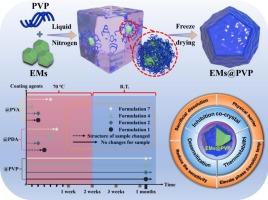核壳复合涂层对CL-20和HMX晶体抑制共结晶的双重抑制机理
IF 7.9
2区 材料科学
Q1 MATERIALS SCIENCE, MULTIDISCIPLINARY
引用次数: 0
摘要
在长期储存过程中,六硝基六氮杂索乌兹坦(CL-20)和环四亚甲基四硝胺(HMX)的意外共结晶会损害复合推进剂的结构完整性和安全性。受药物结晶控制的启发,本研究提出了一种胶体界面工程策略,通过冷冻干燥在CL-20和HMX晶体上使用保形聚乙烯吡咯烷酮(PVP)涂层。涂层策略表现出“牺牲溶解”和“物理屏障”双重缓蚀机制。PVP通过控制溶解优先饱和缩水甘油酯叠氮聚合物(GAP)粘结剂,使溶解CL-20和HMX的能力失活。同时,PVP对增塑剂癸酸二辛酯(DOS)的渗透形成了致密的屏障。分子动力学模拟和密度泛函理论计算证实PVP与CL-20和HMX表面具有良好的结合亲和力,并通过x射线光电子能谱和原子力显微镜验证了这一点。加速老化试验(70°C/30天)表明pvp涂层配方完全抑制共结晶。热分析表明,由于限制分子迁移率和优化散热,相变温度升高20-30°C,活化能增强。机械灵敏度降低了50 - 100%,而燃烧速率提高了18 - 33%。这项工作将药物启发的界面控制与高能材料联系起来,通过动力学控制建立了稳定高能复合材料的通用方法。本文章由计算机程序翻译,如有差异,请以英文原文为准。

Dual inhibition mechanism of core-shell coatings on CL-20 and HMX crystals for suppressing co-crystallization in composite propellants
The unintended co-crystallization of hexanitrohexaazaisowurtzitane (CL-20) and cyclotetramethylene tetranitramine (HMX) compromises the structural integrity and safety of composite propellants during long-term storage. Inspired by pharmaceutical crystallization control, this study proposes a colloidal interface engineering strategy that utilizes conformal polyvinylpyrrolidone (PVP) coatings on CL-20 and HMX crystals by freeze-drying. The coatings strategy exhibit “sacrificial dissolution” and “physical barrier” dual inhibition mechanism. PVP preferentially saturates the glycidyl azide polymer (GAP) binder through controlled dissolution, deactivating the capacity to dissolve CL-20 and HMX. Simultaneously, PVP forms a dense barrier against plasticizer dioctyl sebacate (DOS) penetration. Molecular dynamics simulations and density functional theory calculations confirmed superior PVP binding affinity to CL-20 and HMX surfaces, which is validated by X-ray photoelectron spectroscopy and atomic force microscopy. Accelerated aging tests (70 °C/30 days) demonstrated complete co-crystallization suppression in PVP-coated formulations. Thermal analysis revealed a 20-30°C increase in phase transition temperatures and enhanced activation energies, attributed to restricted molecular mobility and optimized heat dissipation. Mechanical sensitivity decreased by 50–100 %, while combustion rates increased by 18–33 %. This work bridges pharmaceutical-inspired interfacial control with energetic materials, establishing a universal methodology for stabilizing high-energy composites through kinetic control.
求助全文
通过发布文献求助,成功后即可免费获取论文全文。
去求助
来源期刊

Materials & Design
Engineering-Mechanical Engineering
CiteScore
14.30
自引率
7.10%
发文量
1028
审稿时长
85 days
期刊介绍:
Materials and Design is a multi-disciplinary journal that publishes original research reports, review articles, and express communications. The journal focuses on studying the structure and properties of inorganic and organic materials, advancements in synthesis, processing, characterization, and testing, the design of materials and engineering systems, and their applications in technology. It aims to bring together various aspects of materials science, engineering, physics, and chemistry.
The journal explores themes ranging from materials to design and aims to reveal the connections between natural and artificial materials, as well as experiment and modeling. Manuscripts submitted to Materials and Design should contain elements of discovery and surprise, as they often contribute new insights into the architecture and function of matter.
 求助内容:
求助内容: 应助结果提醒方式:
应助结果提醒方式:


